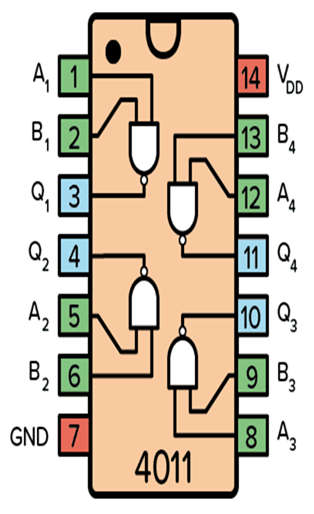- The CD4011 is a two-input NAND gate integrated circuit. It is a quadrable NAND gate integrated circuit, which means that it contains four NAND gates in a single package. It is built with CMOS logic.
- The CMOS logic voltage level is used to design all inputs and outputs. It is used to execute NAND logic, but it can also perform ‘AND A= X x Y’ or ‘OR B = X+Y’ operations using a combination of four gates. NAND’s logical inputs and outputs. For throughput, I/O pins are buffered.
- CD4011 packages are available in 14-lead hermetic dual-in-line ceramic (F3A suffix), 14-lead dual-in-line plastic (E suffix), 14-lead small-outline (M, MT, M96, and NSR suffixes), and 14-lead thin shrink small-outline configurations (PWR suffix). CD4011s are also available in 14-lead thin shrink small-outline packages (PW suffix).

- D4011 NAND gates supplement the existing family of CMOS gates by providing the system designer with direct implementation of the NAND function.
- Now before we jump to the pin configurations and applications, first of all, let us understand what is a NAND gate and what functions does it serve?
- A NAND Gate is the logic gate that is the inverse of an AND gate. It is a common logic gate that is made up of AND and NOT gates. It is known as a “universal” gate in Boolean algebra because it can produce all other logic gates.
- A NAND gate is made up of one or more inputs and a single output. The NAND gate’s output is always logic 1 and only goes to logic 0 when all of the NAND gate’s inputs are logic 1. In other words, the NAND gate’s output is always true if at least one of its inputs is false.
![]()
- The NAND gate function is also known as the Sheffer Stroke function. If all of the NAND gate’s inputs are true, the output is false. It is represented by a symbol that looks like an AND gate with a circle on top, also known as an “inversion circle.”, as shown below.
![]()
Pin Configuration

| Pin Name | Pin No. | Type | Description |
|---|---|---|---|
| VDD | 14 | Power | Supply Voltage (+3 to +15V) |
| GND | 7 | Power | Ground (0V) |
| B1 to B4 | 2,6,9,13 | Input | Inputs B of the four NAND gates |
| Q1 to Q4 | 3,4,10,11 | Output | Outputs from the four NAND gates |
Features of CD4011 NAND Gate
- NAND Gate with Dual Input – Quad Package.
- 5V is the typical operating voltage.
- 1.5 mA is the high-level output current.
- 1.5mA is the low-level output current.
- Propagation Delay: 60 ns.
- Temperature range of operation: 55 C to + 125 C.
- 14-pin PDIP, GDIP, and PDSO packages are available.
Applications of CD4011 NAND Gate
- AV Receivers.
- Portable Audio Docks.
- Blu-Ray Players.
- Home Theater.
- MP3 Players or Recorders.
- Personal Digital Assistants (PDAs).
